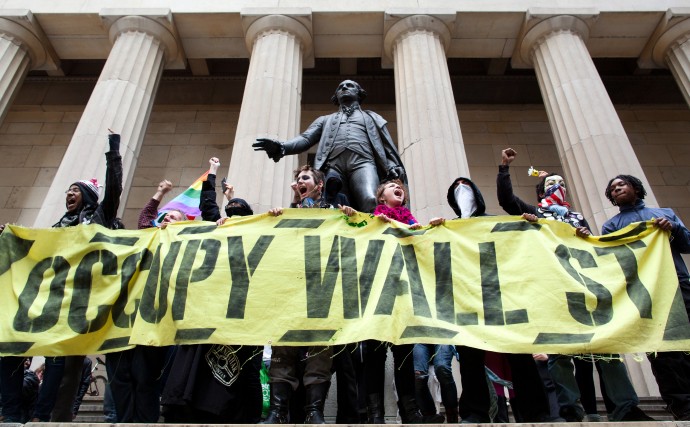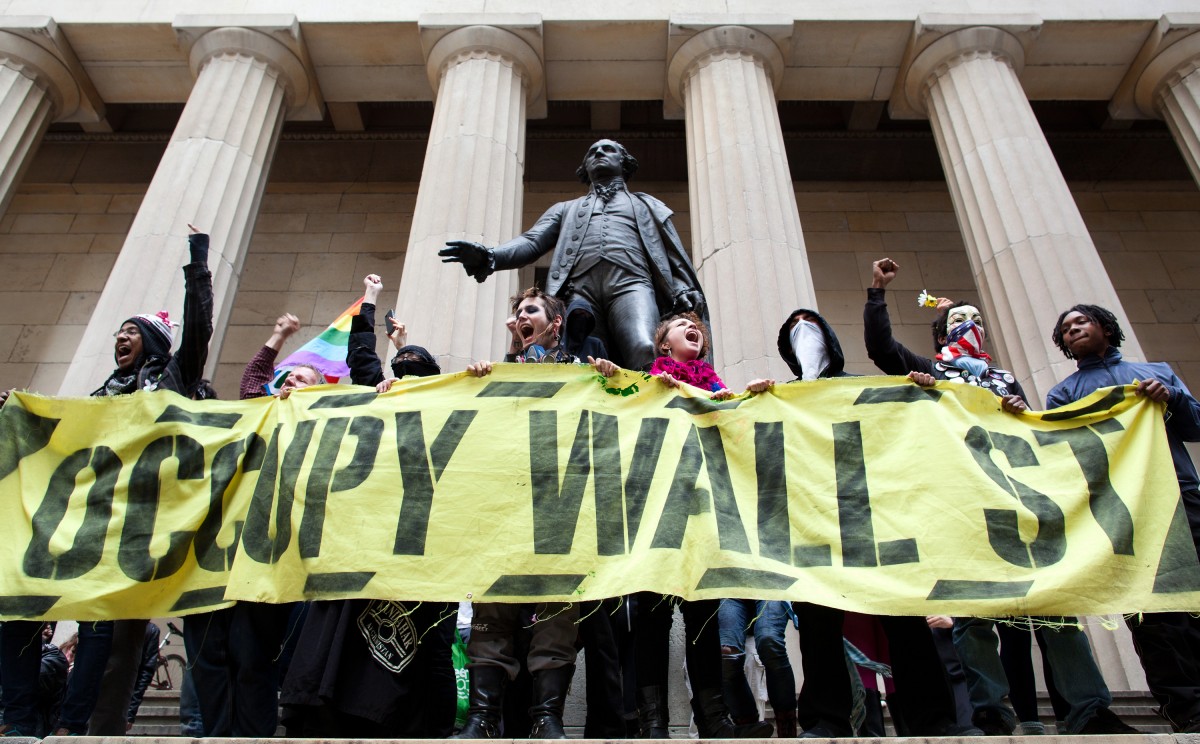
It’s been two years since the Occupy Wall Street movement burst onto the scene, challenging a bevy of economic problems including corporate greed, growing economic inequalities and reckless the Wall Street practices that triggered the 2008 economic crisis and threw 5.5 million people out of work and lead to nearly 4 million home foreclosures.
The movement saw thousands taking to parks and other public spaces across the country, and eventually the world.
“We are the 99 percent” and “Banks got bailed out, we got sold out” became common chants as thousands of protesters set up makeshift encampments, most notably at Zuccotti Park in Lower Manhattan in New York City.
Two years later, the encampments are gone and the economic conditions underpinning the movement have arguably gotten worse. A report released this week by an economist at the University of California-Berkeley shows that income inequality in the U.S. economy is at a new high. As the economy struggles five years after the Great Recession, income inequality broke records going back nearly 100 years.
While some have sung the death knells of Occupy and the fight for economic justice, a look at recent movements shows that when it comes to fighting for change, it’s almost always a marathon, not a sprint.
The Civil Rights movement took decades of protests in the Jim Crow South until Congress passed the Civil Rights Amendment in 1964 and the Voting Rights Act in 1965. Similarly, South Africa’s anti-apartheid government was brought down after 46 years of boycotts and protests.
Occupy’s chapter I is closed, but protests around the economy could be entering entering chapter II in the form of living wage campaigns across the fast food sector.
Revolutions rarely unfold in a single step
“The rich have recovered, but the rest still struggle. This cannot long stand. So, the Occupy Wall Street movement, which many dismissed as the wails of the young and disaffected without clear objectives, clear leaders or a clear political agenda, may, in the end, have a rather clear legacy: ingraining in the national conscience the idea that our extreme levels of inequality are politically untenable and morally unacceptable, and that eventually the 99 percent will demand better,” writes Charles M. Blow, a New York Times columnist reflecting on the two-year anniversary of OWS.
Why did Occupy fail? The police crackdown against the protesters was swift. Thousands of nonviolent protesters and independent journalists covering Occupy demonstrations were arrested. Occupyarrests.com reports that as of June 2013 there have been 7,762 arrests of occupiers. Declassified documents obtained by the Partnership for Civil Justice Fund later revealed that the FBI referred to OWS protests as “criminal activity” or even “domestic terrorism.”
The final blow came when police moved in and cleared encampments one by one in November 2011. Contingents of the Occupy movement continue to advocate for an end to home foreclosures and debt forgiveness, but the heart of the movement died with the end of the encampments.
Two years after the demise of visible Occupy encampments, some fast food workers say that they are picking up where OWS has left off. The chants and banners may differ, but the underlying economic inequalities and low pay continue to drive protests through 2013.
“Call it Occupy 2.0. Organizations with Twitter-ready names such as ‘Low Pay Is Not OK’ and ‘Fast Food Forward’ have helped galvanize the workers, and hashtags such as ‘#strikefor15’ and ‘#iamfastfood’ have instantly shared pictures of the protests and pin-pointed their locations in real time,” the Christian Science Monitor reported in July, during a nationwide protest across the fast food industry. For more than a year, protesters have demanded $15 an hour wages and the right to form a union without intimidation.
Last month, fast food workers across 50 cities and 1,000 stores walked off the job in the latest iteration of strikes in the low wage sector.
“The Occupy movement created sort of a consciousness, a political space to talk about income inequality, and these workers really relate to the idea of the 99 percent,” says Hilary Klein, director of Make the Road New York, a community advocacy group with offices throughout New York City.
When concessions can quell opposition
Without a clear set of demands or leadership, Occupy eventually crumbled under the pressure of police. “With a list of demands as schizophrenic as ending joblessness, ‘the modern gilded age,’ political corruption, and capital punishment,” the Times’ Ginia Bellafante concluded on Saturday that protesters were “pantomiming progressivism rather than practicing it knowledgeably.”
In some countries like Brazil, governments appear to be more conciliatory to the demands of the protesters when programmatic points for reform are clear. Here’s a brief history of the protests that rocked Brazil earlier this summer:
In June, citizens began protesting proposed hikes to public transit fares. The Movimento Passe Livre (Free Fare Movement), a local entity that advocates for free public transportation, began organizing protests that quickly spread across Rio de Janeiro, Sao Paulo and other major cities, encompassing a range of economic issues.
“The only ones who do something for us are the businesses,” said Fatima Souza in a statement to CNN. “We don’t have hospitals. The only place where we can take our children is the Einstein, a community program that is privately financed. When I ask for a visit, they give me an appointment in three months or more.”
The Brazilian police used force in an attempt to stifle protests leading to 10 deaths, 650 injuries and hundreds of arrests. One big reason for the success was a much larger protester turnout. Where Occupy mustered 10,000-20,000 people during its largest protest in October 2011, over 2 million Brazilians protested in 100 cities during June and July.
The show of strength was enough to force the hand of President Dilma Rousseff, who pledged to spend 50 billion Brazilian reals (R$) on improving urban public transportation after a meeting with protest leaders June 24.
It was one of five points of the proposed “national pact” that called for turning corruption from a misdemeanor to a felony, forming a constituent assembly to consider political reform, investing R$50 billion (about $23 billion) in city transport, increased spending on education and health, and emphasizing the importance of fiscal responsibility.
Revolution: it’s always a matter of bread…
Winning a few important economic concessions, however, doesn’t necessarily amount to a revolution that changes political leadership and fundamentally alters the economic and social organization of a country.
There are, of course, times when reducing bus fares or making economic concessions simply isn’t enough to quell the revolutionary tide of the masses. The basis of revolutions that bring down governments is almost always a question of bread.
“Worsening economic and social conditions for the poor and middle class were major factors behind last year’s Tahrir Uprising. These workers say that life has only gotten harder under the Military Junta that replaced former President Hosni Mubarak,” the Real News reported last year.
Like the police response in Brazil, police repression during the 2011-2012 protests lead to the deaths of at least 88 protesters and hundreds of arrests.
“Bread, freedom, social justice,” became the calling card of Egyptians before, during and after the overthrow of Hosni Mubarak. “As long as there is corruption in government and society, while workers and the poor continue to be oppressed, then the revolutionary demands have not been met,” said one protester.
Muslim Brotherhood-affiliated candidate Mohamed Morsi was ushered in promising to turn the page on the Mubarak era — but again the economy faltered and little was done to remedy economic conditions.
The United Nations issued a report in May claiming that poverty and food insecurity in Egypt have risen significantly over the last three years.
An estimated 13.7 million Egyptians, about 17 percent of the population, suffered from food insecurity in 2011, compared with 14 per cent in 2009, according to the report by U.N. World Food Programme and the Egyptian Central Agency for Public Mobilization and Statistics.
“This increase in food insecurity, malnutrition and poverty rates has not happened overnight, during this year or even during the past year,” said WFP Egypt Representative and Country Director GianPietro Bordignon.
Protests against economic woes did not begin with Mubarak. In 1977, hundreds clashed with police when Anwar Sadat announced the end of food subsidies, triggering bread riots across the country when people could no longer afford to feed their families.
The announcement followed International Monetary Fund-issued dictates to the Sadat government to remove food subsidies as a condition of economic structural adjustment. Protests didn’t bring down the Sadat government, but they did force his hand to reinstate subsidies for bread. Seventy-nine people were killed and over 550 injured over the course of the protest.


